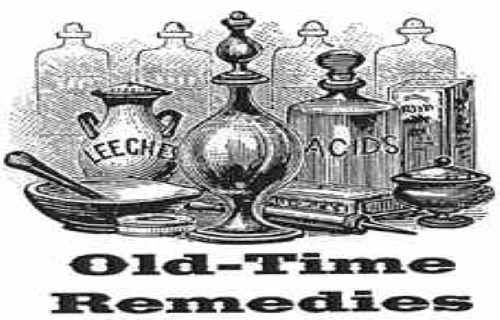
At every step in the trek westward, America’s pioneers found an enemy more ubiquitous, more stealthy, and more deadly than the Indians, yet in our histories we tend to forget this dread opponent. It was, quite simply, disease. Epidemics of malaria ravaged frontier settlements through most of Ohio, Indiana, Illinois, and Michigan. In the gold camps of California, cholera, malaria, typhoid, and scurvy struck down even the hardiest fortune seekers. Scarlet fever, yellow fever, diphtheria, smallpox, tuberculosis, and influenza attacked settlers along the westbound way. In addition to these scourges, fatalistically received as acts of God, there was violence, and the festering ills it trailed behind.
Against such hazards there were few defenses. Pioneers closed themselves with folk remedies and patent medicines, believing as a general rule that strongsmelling, vile-tasting, thoroughly disagreeable treatments were the most effective. Drinking sulphur, for instance, was thought to be good for almost anything. When the illness was really grave, they summoned what was rather loosely called a doctor—if there was one within fifty miles.
In this institutional void, more than a dozen systems and theories of medicine sprang up. Steam baths, free/ing baths, weird diets, secret Indian herbs, and the draining away of bad blood—each theory of healing had its partisans. The contending camps engaged in fierce disputes while borrowing so freely of each other’s methods that it was often hard to tell where one system ended and another began. The confusion gave rise to a group called eclectics, or people’s doctors, who practiced medicine on the democratic frontier principle that one man’s opinion was as good as another’s. Some people’s doctors claimed to be equally proficient in all methods, and allowed the patients to choose the treatments they preferred.
In a world without antibiotics, how did doctors treat infections?
The development of antibiotics and other antimicrobial therapies is arguably the greatest achievement of modern medicine. However, overuse and misuse of antimicrobial therapy predictably leads to resistance in microorganisms. Antibiotic-resistant bacteria such as methicillin-resistant Staphylococcus aureus (MRSA), vancomycin-resistant Enterococcus species (VRE) and carbapenem-resistant Enterobacteriaceae (CRE) have emerged. Certain CRE species are resistant to multiple antibiotics, and have been deemed “superbugs” in the news.
Alternative therapies have been used to treat infections since antiquity, but none are as reliably safe and effective as modern antimicrobial therapy.
Unfortunately, due to increasing resistance and lack of development of new agents, the possibility of a return to the pre-antimicrobial era may become a reality.
So how were infections treated before antimicrobials were developed in the early 20th century?
Blood, leeches and knives
Bloodletting was used as a medical therapy for over 3,000 years. It originated in Egypt in 1000 B.C. and was used until the middle of the 20th century.
Medical texts from antiquity all the way up until 1940s recommend bloodletting for a wide variety of conditions, but particularly for infections. As late as 1942, William Osler’s 14th edition of Principles and Practice of Medicine, historically the preeminent textbook of internal medicine, included bloodletting as a treatment for pneumonia.
Bloodletting is based on an ancient medical theory that the four bodily fluids, or “humors” (blood, phlegm, black bile and yellow bile), must remain in balance to preserve health. Infections were thought to be caused by an excess of blood, so blood was removed from the afflicted patient. One method was to make an incision in a vein or artery, but it was not the only one. Cupping was another common method, in which heated glass cups were placed on the skin, creating a vacuum, breaking small blood vessels and resulting in large areas of bleeding under the skin. Most infamously, leeches were also used as a variant of bloodletting.
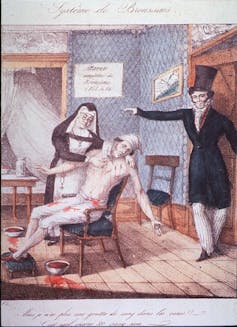
Interestingly, though bloodletting was recommended by physicians, the practice was actually performed by barbers, or “barber-surgeons.” The red and white striped pole of the barbershop originated as “advertising” their bloodletting services, the red symbolizing blood and the white symbolizing bandages.
There may actually have been some benefit to the practice – at least for certain kinds of bacteria in the early stages of infection. Many bacteria require iron to replicate, and iron is carried on heme, a component of the red blood cell. In theory, fewer red blood cells resulted in less available iron to sustain the bacterial infection.
Some mercury for your syphilis?
Naturally occurring chemical elements and chemical compounds have historically have been used as therapies for a variety of infections, particularly for wound infections and syphilis.
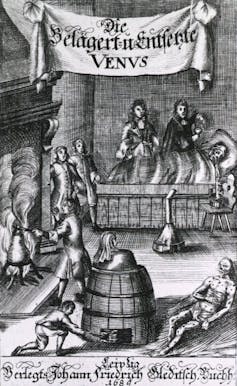
Topical iodine, bromine and mercury-containing compounds were used to treat infected wounds and gangrene during the American Civil War. Bromine was used most frequently, but was very painful when applied topically or injected into a wound, and could cause tissue damage itself. These treatments inhibited bacterial cell replication, but they could also harm normal human cells.
Mercury compounds were used to treat syphilis from about 1363 to 1910. The compounds could be applied to skin, taken orally or injected. But the side effects could include extensive damage to skin and mucous membranes, kidney and brain damage, and even death. Arsphenamine, an arsenic derivative, was also used in the first half of the 20th century. Though it was effective, side effects included optic neuritis, seizures, fever, kidney injury and rash.
Thankfully, in 1943, penicillin supplanted these treatments and remains the first-line therapy for all stages of syphilis.
Looking in the garden
Over the centuries, a variety of herbal remedies evolved for the treatment of infections, but very few have been evaluated by controlled clinical trials.
One of the more famous herbally derived therapies is quinine, which was used to treat malaria. It was originally isolated from the bark of the cinchona tree, which is native to South America. Today we use a synthetic form of quinine to treat the disease. Before that, cinchona bark was dried, ground into powder, and mixed with water for people to drink. The use of cinchona bark to treat fevers was described by Jesuit missionaries in the 1600s, though it was likely used in native populations much earlier.
Artemisinin, which was synthesized from the Artemisia annua (sweet wormwood) plant is another effective malaria treatment. A Chinese scientist, Dr. Tu Youyou, and her team analyzed ancient Chinese medical texts and folk remedies, identifying extracts from Artemisia annua as effectively inhibiting the replication of the malaria parasite in animals. Tu Youyou was coawarded the 2015 Nobel Prize in Physiology or Medicine for the discovery of artemisinin.
You probably have botantically derived therapy against wound infection in your kitchen cupboard. The use of honey in wound healing dates back to the Sumerians in 2000 B.C.. The high sugar content can dehydrate bacterial cells, while acidity can inhibit growth and division of many bacteria. Honey also has an enzyme, glucose oxidase, that reduces oxygen to hydrogen peroxide, which kills bacteria.
The most potent naturally occurring honey is thought to be Manuka honey. It is derived from the flower of the tea tree bush, which has additional antibacterial properties.
Like other botanically derived therapies, honey has inspired the creation of pharmaceuticals. MEDIHONEY®, a medical grade product developed by Derma Sciences, is used to promote healing in burns as well as other types of wounds.
Take a look at this collection The Lost Book Of Remedies, taken word for word out of a circa 1845 manual.
What is The Lost Book of Remedies? The Lost Book of Remedies PDF contains a series of medicinal and herbal recipes to make home made remedies from medicinal plants and herbs. Chromic diseases and maladies can be overcome by taking the remedies outlined in this book. The writer claims that his grandfather was taught herbalism and healing whilst in active service during world war two and that he has treated many soldiers with his home made cures.
Combating antimicrobial resistance
While some of these ancient therapies proved effective enough that they are still used in some form today, on the whole they just aren’t as good modern antimicrobials at treating infections. Sadly, thanks to overuse and misuse, antibiotics are becoming less effective.
Each year in the United States, at least two million people become infected with bacteria that are resistant to antibiotics, and at least 23,000 people die each year as a direct result of these infections.
While resistant bacteria are most commonly reported, resistance also can arise in other microorganisms, including fungi, viruses and parasites. Increasing resistance has raised the possibility that certain infections may eventually be untreatable with the antimicrobials we currently have.
The race is on to find new treatments for these infections, and researchers are exploring new therapies and new sources for antibiotics.
Besides using antibiotics as directed and only when necessary, you can avoid infections in the first place with appropriate immunization, safe food-handling practices and washing your hands.
Tracking resistant infections so we can learn more about them and their risk factors, as well as limiting the use of antibiotics in humans and animals, could also help curb the risk of resistant bacteria.
The premise is that many modern day medicines work on the basis that they treat the symptoms and not the cause, but contained within The Lost Book of Remedies are a number of tinctures and tonics made from plants and leaves that will treat the cause of the illness, thus eradicating the disease altogether.
The book is a direct copy of the little notebook carried around by the author’s grandfather when treating his patients. However, the illustrations of the plants have been updated to photographs so that they are easier for you to identify.
Old West Remedy for:—DYSENTERY—
Dissolve as much table salt in pure vinegar as will ferment and work clear. When the foam is discharged cork it up in a bottle, and put it away for use. A large spoonful of this in a gill of boiling water is efficacious in cases of dysentery and cholic.
Old West Remedy for:—CHILLS—
The plant, commonly called hoarhound, is said to afford a certain cure. Boil it in water, and drink freely of the tea.
Old West Remedy for:—SORE THROAT, DIPTHERIA OR SCARLET FEVER—
Mix in a common size cup of fresh milk two teaspoonfuls of pulverized charcoal and ten drops of spirits of turpentine. Soften the charcoal with a few drops of milk before putting into the cup. Gargle frequently, according to the violence of the symptoms.
Old West Remedy for:—ASTHMA RELIEF—
Take the leaves of the stramonium (or Jamestown weed,) dried in the shade, saturated with a pretty strong solution of salt petre, and smoke it so as to inhale the fumes. It may strangle at first if taken too freely, but it will loosen the phlegm in the lungs. The leaves should be gathered before frost.
Old West Remedy for:—CROUP—
If a child is taken with croup apply cold water suddenly and freely to the neck and chest with a sponge or towel. The breathing will instantly be relieved, then wipe it dry, cover it up warm, and soon a quiet slumber will relieve the parent’s anxiety.
Old West Remedy for:—A TROUBLESOME COUGH—
Take of treacle and the best white wine vinegar six tablespoonfuls each, add forty drops of laudanum, mix it well, and put into a bottle. A teaspoonful to be taken occasionally when the cough is troublesome. The mixture will be found efficacious without the laudanum in many cases.
Old West Remedy for:—A SICK HEADACHE—
One teaspoonful of pulverized charcoal and one-third of a teaspoonful of soda mixed in very warm water.
Old West Remedy for:–A TOOTHACHE–
Powdered alum will not only relieve the toothache, but prevent the decay of the tooth. Salt may advantageously be mixed with the alum.
Old West Remedy for:—A BURN—
Wheat flour and cold water, mixed to the consistency of soft paste, is an almost instantaneous cure for a burn. Renew before the first gets dry so as to stick.
Old West Remedy for:—CAMP ITCH—
Take iodide of potassium, sixty grains, lard, two ounces, mix well, and after washing the body well with warm soap suds rub the ointment over the person three times a week. In seven or eight days the acarus or itch insect will be destroyed. In this recipe the horrible effects of the old sulphur ointment are obviated.
Old West Remedy for:—A FELON—
The Selma Reporter says: A poultice of onions, applied morning, noon and night for three or four days, will cure a felon. No matter how bad the case, splitting the finger will be unnecessary, if this poultice be used. We have seen it tried several times, and know that the remedy is a sure, safe and speedy one.
Old West Remedy for:—CORNS—
The cause of corns, and likewise the pain they occasion, is simply friction, and to lessen the friction you have only to use your toe as you do in like circumstances a coach wheel–lubricate it with some oily substance. The best thing to use is a little sweet oil rubbed on the affected part (after the corn is carefully pared) with the tip of the finger, which should be done on getting up in the morning, and just before stepping into bed at night. In a few days the pain will diminish, and in a few days more it will cease, when the nightly application may be discontinued.
Old West Remedy for:—WARTS—
Dissolve as much common washing soda as the water will take up, wash the warts with this for a minute or two, and let them dry without wiping. Keep the water in a bottle and repeat the washing often, and it will take away the largest of warts.
Old West Remedy for: —Bleeding—
Home remedies called for using wood ashes or cobwebs to staunch the flow of blood. People also put gunpowder or flour on cuts to staunch bleeding.
Old West Remedy for:—Cholera—
Treated with red pepper in whiskey or brandy, or burning barrels of pine tar beneath open windows (though that had no real effect). In 1849 on the Santa Fe Trail, Dr. Burchard gave pills compounded of camphor, cayenne pepper, opium and calomel or rectal injections of a medicine made from sugar of lead, laudanum and gum arabica.
Old West Remedy for:—Cough—
Treated with onion syrup or paregoric (a mixture of opium and camphor). To promote expectoration doctors used carbonate of ammonia or muriate. They also used a mixture of equal parts of linseed oil, honey and Jamaica rum.
Old West Remedy for:–Fever—
Doctors used coal tar derivatives as sleep producers. People also treated fevers with sassafras tea and used aconite to control them. In 1866 a doctor recommended a liniment mixture of sulphuric ether, aqua ammonia, and muriate of ammonia. “Wet the scalp and all painful parts every 2 or 3 hours, or until the pain abates.”
Old West Remedy for:—Scalping—
Often, but not always, fatal. A four-year-old Nebraska boy had his scalp reattached by a doctor using thirty-five sutures. The doctor then put a wet skullcap on the head which was kept wet with a solution of boric acid. The child recovered.
Old West Remedy for:—Snakebite—
Raw beef slabs or chicken flesh were used to draw out poison as was “vinegar mixed with gunpowder. Some would cauterize the bite with nitrate of silver then give the patient ammonia and whiskey. When a Dr. Woodhouse was snakebit, he utilized every type of treatment he could to cure himself including brandy, whiskey, ammonia water, flaxseed poultice, Dover’s Powders, extract of collocynth, tincture of iodine, magnesia calci, Seidlitz powders, potassium iodide and peppermint water. He recovered.
Old West Remedy for:–Yellow Fever—
Characterized by chills, high temperatures, headaches, delirium and swollen joints. Treatment included doses of quinine, sulphate of magneis and calomel, which were only partially effective and fatal relapses were common.
The Lost Book of Remedies is the revolutionary e-book which is suitable for one of the tools in survival kit because the creator of this program was mentioned lots of benefits about natural medicinal herbs and ingredients to make you feel safe, secure by protecting the health of yourself and dependents in any crisis. Even you can plant it in your backyard to grow effective medicinal herbs to save the life of anyone without wasting your money and time. This e-book will guide you on the right path to provide security, water, food, and all the medicines for securing your life or loved ones at all the time. This guide discussed the common plants that are grown in your backyard, but you don’t know the benefits of that plan which may help you to overcome any significant issues. Sometimes it may replace your antibiotic pills, reduce inflammations, stops bleeding, reverse arthritis, lowers cholesterol, regulates blood sugar level, defeats degenerative brain diseases and much more.
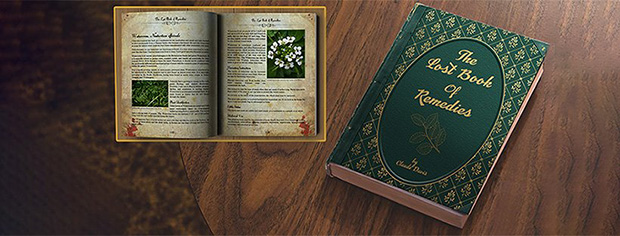
Books can be your best pre-collapse investment.
Carnivore’s Bible (is a wellknown meat processor providing custom meat processing services locally andacross the state of Montana and more. Whether your needs are for domestic meator wild game meat processing)
The Lost Book of Remedies PDF ( contains a series of medicinal andherbal recipes to make home made remedies from medicinal plants and herbs.Chromic diseases and maladies can be overcome by taking the remediesoutlined in this book. The writer claims that his grandfather was taughtherbalism and healing whilst in active service during world war twoand that he has treated many soldiers with his home made cures. )
Easy Cellar(Info about building and managing your root cellar, plus printable plans. The book on building and using root cellars – The Complete Root Cellar Book.)
The Lost Ways (Learn the long forgotten secrets that helped our forefathers survive famines,wars,economic crisis and anything else life threw at them)
LOST WAYS 2 ( Wordof the day: Prepare! And do it the old fashion way, like our fore-fathers did it and succeed longbefore us,because what lies ahead of us will require all the help we can get. Watch this video and learn the 3 skills that ensured our ancestors survival in hard times offamine and war.)
Survival MD (Best Post Collapse First Aid Survival Guide Ever)
Conquering the coming collapse (Financial advice and preparedness )
Liberty Generator (Build and make your own energy source)
Backyard Liberty (Easy and cheap DIY Aquaponic system to grow your organic and living food bank)
Bullet Proof Home (A Prepper’s Guide in Safeguarding a Home )
Family Self Defense (Best Self Defense Strategies For You And Your Family)
Survive Any Crisis (Best Items To Hoard For A Long Term Crisis)
Survive The End Days(Biggest Cover Up Of Our President)
Drought USA(Discover The Amazing Device That Turns Air Into Water)

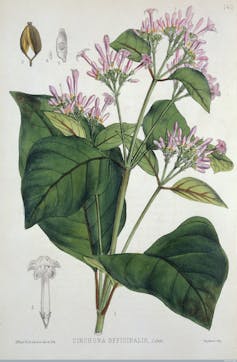

I would love to have this e book.
I love anything about old time cures.